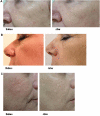A novel fractional micro-plasma radio-frequency technology for the treatment of facial scars and rhytids: a pilot study
- PMID: 20825258
- PMCID: PMC2956449
- DOI: 10.3109/14764172.2010.514921
A novel fractional micro-plasma radio-frequency technology for the treatment of facial scars and rhytids: a pilot study
Abstract
Introduction: Fractional ablative and non-ablative lasers have gained popularity in the treatment of acne scars and rhytids due to their efficacy and improved tolerability. Plasma and radio frequency (RF) have also emerged as methods for ablative or non-ablative energy delivery. We report preliminary experience with a novel fractional micro-plasma RF device for the treatment of facial acne scars and rhytids.
Methods: Sixteen patients with facial acne scars or rhytids were treated at 4-week intervals. Treatment parameters were titrated to an immediate end point of moderate erythema. The clinical end point for cessation of treatment was the attainment of satisfactory clinical results. Results were monitored photographically up to 3 months after treatment.
Results: Acne scars showed marked improvement after two to four treatments. Facial rhytids demonstrated reduced depth after two treatments and marked improvement after four treatments. Treatment was well tolerated by all participants, with transient erythema and short downtime. These results provide initial evidence for the safety and effectiveness of fractional micro-plasma RF as a low-downtime and well-tolerated modality for the treatment of acne scars and facial rhytids.
Figures





References
-
- Manstein D, Herron GS, Sink RK, Tanner H, Anderson RR. Fractional photothermolysis: A new concept for cutaneous remodeling using microscopic patterns of thermal injury. Lasers Surg Med. 2004;34(5):426–38. - PubMed
-
- Laubach HJ, Tannous Z, Anderson RR, Manstein D. Skin responses to fractional photothermolysis. Lasers Surg Med. 2006;38(2):142–9. - PubMed
-
- Gold MH. Fractional technology: A review and clinical approaches. J Drugs Dermatol. 2007;6(8):849–52. - PubMed
-
- Alexiades-Armenakas MR, Dover JS, Arndt KA. The spectrum of laser skin resurfacing: Nonablative, fractional, and ablative laser resurfacing. J Am Acad Dermatol. 2008;58(5):719–37. quiz 738-40. - PubMed
-
- Chapas AM, Brightman L, Sukal S, Hale E, Daniel D, Bernstein LJ, et al. Successful treatment of acneiform scarring with CO2 ablative fractional resurfacing. Lasers Surg Med. 2008;40(6):381–6. - PubMed
Publication types
MeSH terms
LinkOut - more resources
Full Text Sources
Medical
